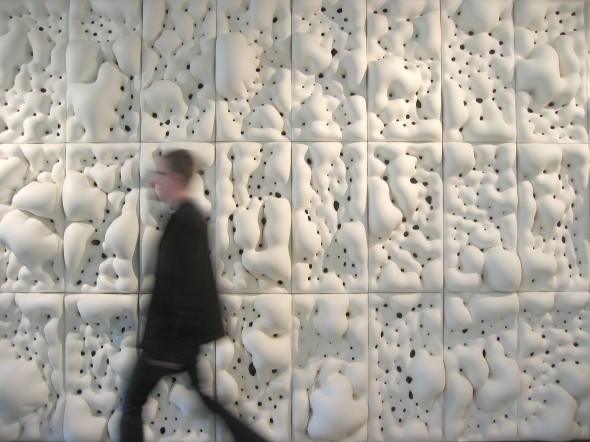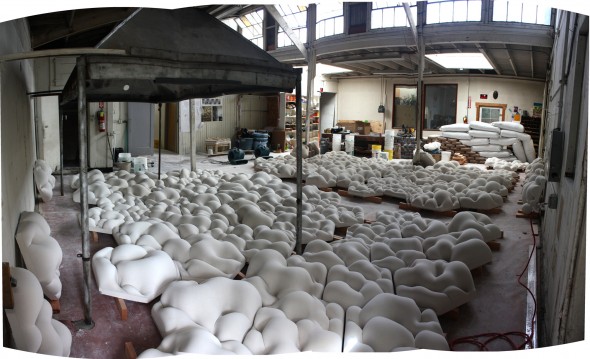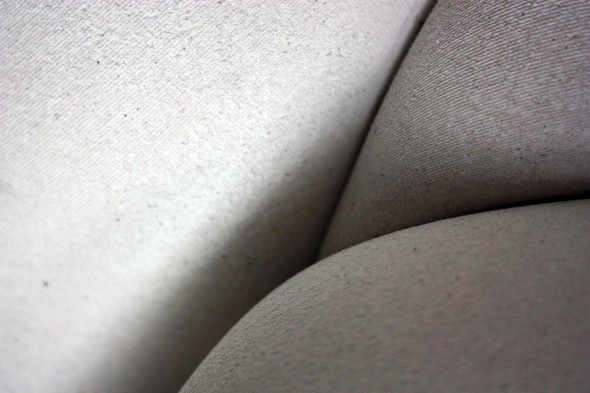Matsys: P_Wall
 Matsys, P_Wall. Banvard Gallery, Knowlton School of Architecture, Ohio State University, Columbus, Ohio.
15′ x 9′ x 1′, 200
Matsys, P_Wall. Banvard Gallery, Knowlton School of Architecture, Ohio State University, Columbus, Ohio.
15′ x 9′ x 1′, 200
Matsys, the studio of Andrew Kudless, investigates architecture as a material 'body' with its own behaviours, forms and processes of integration. One of the most photogenic projects is P_Wall, which uses plaster and nylon fabric. Lest one think this is a random or organic form, it actually derives from pattern analysis. From Matsys's website: 'Starting from an image, a cloud of points is generated based on the image’s grayscale values. These points are then used to mark the positions of dowels which constrain the elasticity in the fabric formwork. Plaster is then poured into the mould and the fabric expands under the weight of the plaster. The resultant plaster tile has a certain resonance with the body as it sags, expands, and stretches in its own relationship with gravity and structure. Assembled into a larger surface, a pattern emerges between the initial image’s grayscale tones and the shadows produced by the wall.'
I love the way we shift from the poetry of 'a cloud of points' to the clunkiness of dowels; such is the process of making architecture. However, another phrase, 'the self-organization of material under force' is a powerful concept.
 Matsys, studio: P-Wall tiles drying, 2009.In 2009 San Francisco Museum of Modern Art commissioned a 45' x 12' P_Wall for the exhibition Sensate: Bodies and Design. Because this kind of hard surfaced building material – they are essentially tiles, to be attached to walls – is unlike any other we have seen, the form calls up any number of metaphoric readings. Henry Urbach, the curator of Sensate' in his curatorial essay went directly to the parallels with the human body, as if we were also stretchy sacs pinned together, bulging with the weight of too much weight.
Matsys, studio: P-Wall tiles drying, 2009.In 2009 San Francisco Museum of Modern Art commissioned a 45' x 12' P_Wall for the exhibition Sensate: Bodies and Design. Because this kind of hard surfaced building material – they are essentially tiles, to be attached to walls – is unlike any other we have seen, the form calls up any number of metaphoric readings. Henry Urbach, the curator of Sensate' in his curatorial essay went directly to the parallels with the human body, as if we were also stretchy sacs pinned together, bulging with the weight of too much weight.
A detail shown on the Matsys documentation of this SFMOMO installation is innocently captioned, 'Detail of a crease. Notice the surface texture left by the fabric form.' Well, yes, we can see the delicate texture of the original knit fabric, but we can also see Weston's photographs of vegetables and nudes — clearly and purposefully sensual.
 Edward Weston, Pepper, 1930; Nude, 1927. Edward Weston negatives, Cole Weston prints.
Edward Weston, Pepper, 1930; Nude, 1927. Edward Weston negatives, Cole Weston prints. Matsys, P_Wall, 2009. Detail of a crease. Notice the surface texture left by the fabric form.
Matsys, P_Wall, 2009. Detail of a crease. Notice the surface texture left by the fabric form.
